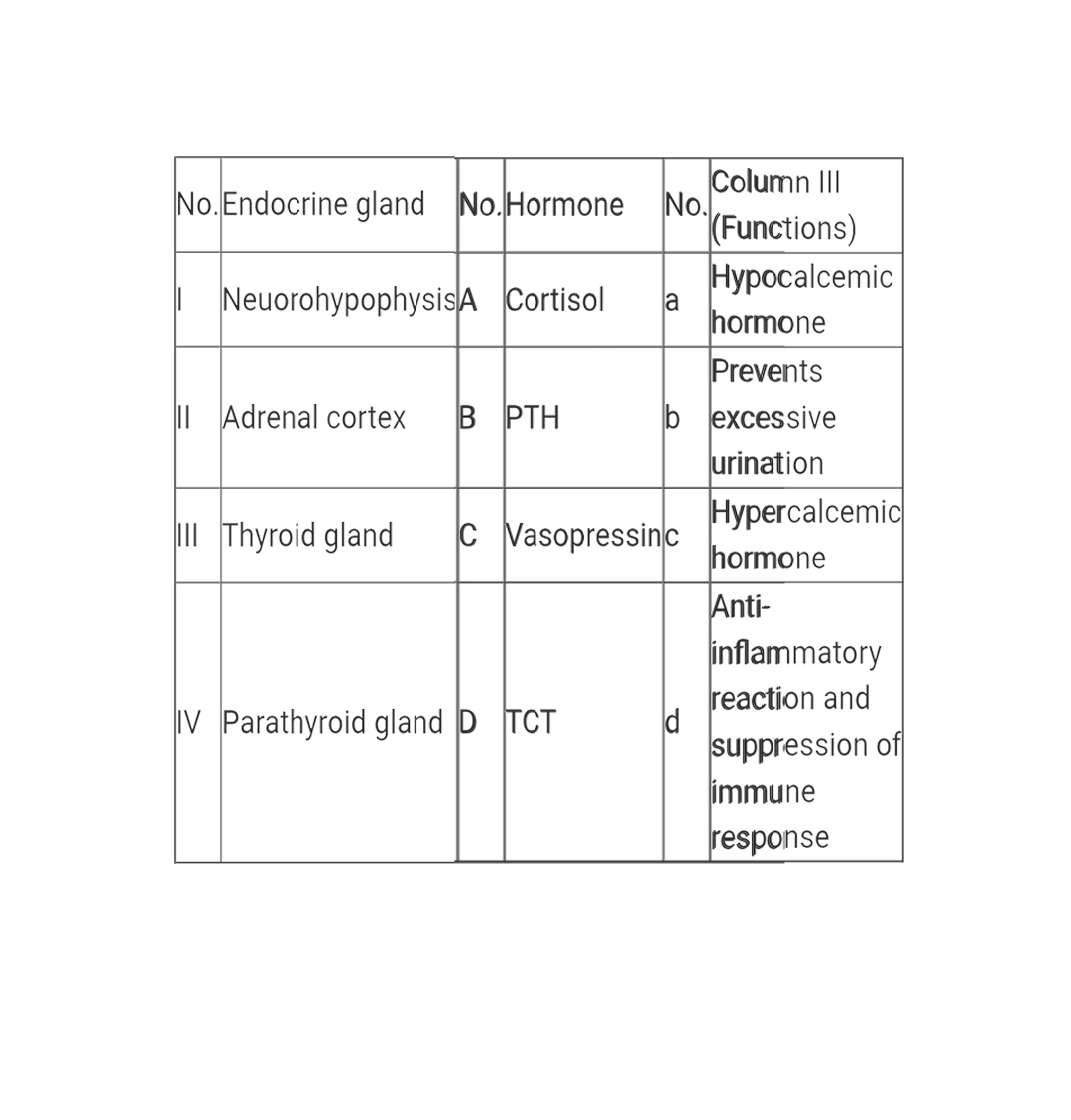Pars distalis region of pituitary does not produce these enzymes
I. Melanocyte stimulating hormone
II. Vasopressin
III. Prolactin
IV. Growth hormone
III only
I and IV only
II and IV only
I and II only
The correct Answer is:D
To solve the question regarding which enzymes are not produced by the pars distalis region of the pituitary gland, we can follow these steps:
1. Understand the Structure of the Pituitary Gland:
- The pituitary gland is divided into two main parts: the adenohypophysis (anterior pituitary) and the neurohypophysis (posterior pituitary).
2. Identify the Regions of the Adenohypophysis:
- The adenohypophysis consists of two regions: pars distalis and pars intermedia.
3. Hormones Produced by Pars Distalis:
- The pars distalis produces several hormones including:
- Growth Hormone (GH)
- Prolactin (PRL)
- Thyroid Stimulating Hormone (TSH)
- Adrenocorticotropic Hormone (ACTH)
- Luteinizing Hormone (LH)
- Follicle Stimulating Hormone (FSH)
4. Hormones Produced by Pars Intermedia:
- The pars intermedia primarily produces Melanocyte Stimulating Hormone (MSH).
5. Hormones Produced by Neurohypophysis:
- The neurohypophysis (specifically the pars nervosa) stores and releases:
- Oxytocin
- Vasopressin (also known as Antidiuretic Hormone, ADH)
6. Analyze the Given Options:
- Now, we need to determine which of the listed hormones are not produced by the pars distalis:
- I. Melanocyte Stimulating Hormone (produced by pars intermedia)
- II. Vasopressin (produced by neurohypophysis)
- III. Prolactin (produced by pars distalis)
- IV. Growth Hormone (produced by pars distalis)
7. Conclusion:
- From the analysis, we find that Melanocyte Stimulating Hormone (I) and Vasopressin (II) are not produced by the pars distalis region. Therefore, the correct answer is I and II only.
Final Answer:
The pars distalis region of the pituitary does not produce Melanocyte Stimulating Hormone (I) and Vasopressin (II).
- The pituitary gland is divided into two main parts: the adenohypophysis (anterior pituitary) and the neurohypophysis (posterior pituitary).
- The adenohypophysis consists of two regions: pars distalis and pars intermedia.
- The pars distalis produces several hormones including:
- Growth Hormone (GH)
- Prolactin (PRL)
- Thyroid Stimulating Hormone (TSH)
- Adrenocorticotropic Hormone (ACTH)
- Luteinizing Hormone (LH)
- Follicle Stimulating Hormone (FSH)
- The pars intermedia primarily produces Melanocyte Stimulating Hormone (MSH).
- The neurohypophysis (specifically the pars nervosa) stores and releases:
- Oxytocin
- Vasopressin (also known as Antidiuretic Hormone, ADH)
- Now, we need to determine which of the listed hormones are not produced by the pars distalis:
- I. Melanocyte Stimulating Hormone (produced by pars intermedia)
- II. Vasopressin (produced by neurohypophysis)
- III. Prolactin (produced by pars distalis)
- IV. Growth Hormone (produced by pars distalis)
- From the analysis, we find that Melanocyte Stimulating Hormone (I) and Vasopressin (II) are not produced by the pars distalis region. Therefore, the correct answer is I and II only.
The pars distalis region of the pituitary does not produce Melanocyte Stimulating Hormone (I) and Vasopressin (II).
Topper's Solved these Questions
- CHEMICAL COORDINATION AND REGULATIONBOOK - DINESH PUBLICATION ENGLISHCHAPTER - CHEMICAL COORDINATION AND REGULATIONEXERCISE - Check Your Grasp
10 Videos
- CHEMICAL COORDINATION AND REGULATIONBOOK - DINESH PUBLICATION ENGLISHCHAPTER - CHEMICAL COORDINATION AND REGULATIONEXERCISE - Brain Teasers-V
114 Videos
- CELL CYCLE (CELL DIVISION)BOOK - DINESH PUBLICATION ENGLISHCHAPTER - CELL CYCLE (CELL DIVISION)EXERCISE - BRAIN TEASERS-III
85 Videos
- CHORDATA- PROTOCHORDATABOOK - DINESH PUBLICATION ENGLISHCHAPTER - CHORDATA- PROTOCHORDATAEXERCISE - CYG
11 Videos
Similar Questions
Statement -I prolactin has no role in males statement-II prolactin is a maternity hormone
View SolutionThe pituitary gland is located in a bony cavity called ___________P_____________ and is attached to hypothalamus by a stalk known as____________________Q__________________ It is divided anatomically into an adenohypophysis and a neurohypophysis. Adenohypophysis consists of two portions, ________R_________ and ______________S____________ The _____________R_______________ region of pituitary, produces _____________________T________________, prolactin (PRL), thyroid stimulating hormone (TSH), adrenocorticotrophic hormone (ACTH) and gonadotropins (luteinizing hormone (LH) and ____________U______________________
View Solution
Knowledge Check
Melanocyte Stimulating Hormone (MSH) is produced by
AA) anterior pituitaryBB) posterior pituitaryCC) pars intermedia of pituitaryDD) parathyroid
Match the endocrine glands gives in column I with their respective hormones in column II and the functions performed by those hormones in column III and select the hormones in column III and select the correct option from the codes given below.

View SolutionGiven below are steps involved in the mechanism of action of hormones. Arrange them in proper sequence and select the correct option.
I. Formation of the hormone - receptor complex .
II. Biochemical changes in the target cell.
III. Binding of the hormone with the receptor.
IV. Physiological responses in the target cell.
View SolutionHow many of the following hormones were synthesised and secreted by pituitary gland ?
* growth hormone
* prolactin
* thyroxine
* aldosterone
* luteinizing hormone
* follicle - stimulating hormone
View SolutionHow many of the following hormones were synthesised and secreted by pituitary gland ?
* growth hormone
* prolactin
* thyroxine
* aldosterone
* luteinizing hormone
* follicle - stimulating hormone
View SolutionHow many of the given statements are true?
1. Pars nervosa stores and releases two hormones called oxytocin and vasopressin.
II. Melatonin influences the menstrual cycle.
III. Calcitonin stimulates reabsorption of Ca2+ by the renal tubules.
IV. After ovulation, the ruptured follicle is converted to macula lutea.
View SolutionRead the following sentences and then answer the given below.
I. Parathyroid hormone regulates the metabolism of calcium.
II. Vasopressin is also called antidiuretic hormone.
III. Grave's disease is caused by malfunctioning of the adrenal gland.
IV. Oxytocin facilitates parturition by acting on the middle layer of the uterus which is made-up of striated involuntary muscles.
View SolutionWhich enzymes are not used for isolation of the DNA?
I. Cellulose
II. Lysozyme
III. Dnase
IV. Lyase
View Solution
